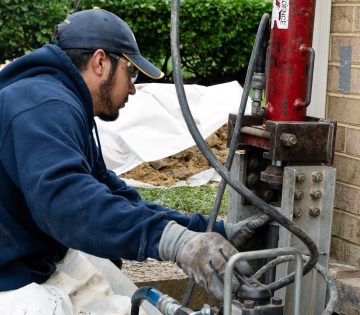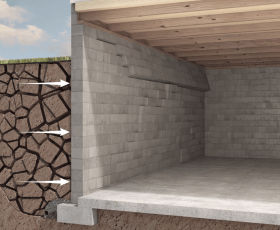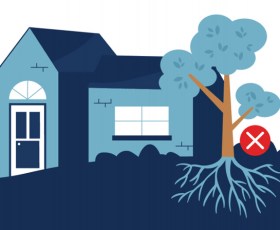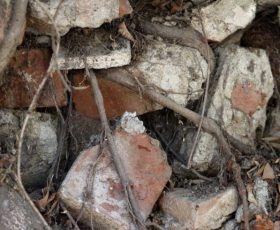Problem Signs
The actual foundation of your house is crucial for your safety and your family’s well-being. However, many more things could be happening below the surface than you realize.
JES Foundation Repair

Cracked Bricks
If you’re noticing cracks in brick wall structures in your home, it’s likely there’s something deeper happening with your foundation.
JES Foundation Repair

Bowed Basement Walls
Bowed basement walls are caused by too much pressure pushing against your basement walls.
JES Foundation Repair

Drywall Cracks
As you start to research drywall cracks around doors, windows, and ceilings, you’ll start to see a variety of types.
JES Foundation Repair

Floor and Wall Gaps
From very slight baseboard peeling to serious cracks, you’re experiencing across your whole home, an expert from JES will be able to give you more information.
Don’t see your foundation issue?
VIEW MORE FOUNDATION PROBLEM SIGNS >
Causes
There are numerous reasons your house may have these problems. Most of these causes stem from the ground.
Expansive soils create foundation damage. Expansive soils, including, clay soil, shrink-swell, and heavable soil, are all different names for the same thing. Expansive soils are responsible for more damage to buildings than any other natural hazard.
This type of soil contains minerals like smectite clays, which absorb a lot of moisture. As the expansive soil soaks up water it expands – up to 15 times its dry volume. Furthermore, the expanded soil then pushes against your foundation and creates cracks or waterproofing problems.
In fact, as the expansive soil dries, it shrinks. The soil shrinkage gives your foundation room to move around. Consequently, this extra room removes the support from your foundation and will cause cracks, settling, and other foundation damage. The pressure of expansive soils against your foundation can exceed 30,000 pounds per square foot.
Deep foundations require a type of foundation repair that has support columns, pillars, or piles. These piers are driven deep into the ground or until they reach bedrock. This is done to provide additional stabilization when the surface soil can no longer support the weight of your home.
These types of foundations require solutions which address problems like settlement or stair-step cracked bricks. For example, if your home has cracked bricks caused by settlement, push piers or resistance piles may be installed. The piers are installed beneath your home’s foundation footing and then driven into bedrock or stable soil.
The piers are installed into stable soil or bedrock because it prevents further settlement and movement. Furthermore, the resistance provided by the stable soil can even help lift your home back to its original level.
When the soil your home is built on can no longer support the weight of your home, the structure will start to settle. An expert may recommend installing a deep foundation system to stabilize your home.
Deep foundation soils and deep foundation systems are best understood by starting with the ground. Soil is made up of obvious layers which have different qualities and are a good indicator of how deep you need to extend your foundation.
The top layers of soil compress and easily compact – this is where settlement occurs and where you’ll find problem soils like expansive clay. The deeper soil layers, like parent rock, are stable and less likely to move. This is why a deep foundation pier system is installed into competent load bearing soils or bedrock.
Can flooding cause foundation damage? Absolutely. In fact, foundations in wet ground almost always end up with cracks and other structural problems. Even if you don’t think you have lots of wet ground around your foundation, even a slight increase in moisture can prove dangerous.
There are many different types of flooding, and unfortunately, most of them can contribute to your foundation cracking. Whether through an act of nature or because of a plumbing problem, these types of water damage may seriously impact your home.
- External Flooding
This type of flooding doesn’t happen inside your home; it happens on the outside. It may be because of a monsoon, a plumbing issue in the neighborhood, or just poor drainage in your area. Regardless of the reason, it’s going to mire your foundation in wet ground, which is never a good thing.
If the area around your home has been dealing with a lot of water recently, it’ll start sinking into the soil. That will make the soil expand and push against your foundation, creating extreme hydrostatic pressure that can easily lead to foundation cracks and water leaks.
- Snow Melting
Heavy snowfall can be a problem for foundations, but it’s not always for the reasons you might think. Many foundations can survive the extreme cold and even the weight of the snow. However, when heavy snow starts to melt, it creates excess flooding.
Similar to other excess flooding, snow melting can create lots of problems for your foundation. If your foundation has any existing cracks, even small ones, water will almost certainly find its way in. As the water starts to evaporate, this can lead to water damage not only in your foundation but in the rest of your home.
- Plumbing Leaks
This type of flooding is almost exclusively internal. If you’re dealing with a plumbing leak, it’s very possible that the leak will end up traveling under your home or inside the walls, which is where most plumbing exists. Many plumbing leaks, then, end up leaking into your basement or crawl space area.
Sometimes, it can be even more difficult to catch foundation issues due to plumbing leaks because you may have to deal with much more visible problems first. If you have a plumbing issue, even if the water mostly impacted the inside of your home, it’s a good idea to schedule a foundation inspection to make sure it didn’t also create foundation problems.
If excess water is a problem, why does the foundation crack when exposed to substantial drought as well? The answer is that steady moisture is the best option for your foundation, so anything that deviates from the standard can cause problems.
It doesn’t matter why you’re experiencing drought. Each reason often ends up causing serious foundation issues. Those issues usually stem from soil expanding and contracting too much, which can lead to cracks and leaks.
- Hot Summers
When rain comes during the wet seasons, it expands the soil like a sponge. Ideally, a dry season should then slowly make the soil shrink again. However, if the season is more hot and dry than normal, it’s possible for it to cause the foundation to settle.
If the summer’s unusually dry, especially if the spring was unusually wet, you’re at higher risk for foundation issues. The gap between the soil and the foundation can create cracks and leaks, allowing for future foundation issues.
- Excessive Evaporation
Ideally, you want the soil around your home to stay about the same moisture at all times. So what happens if you end up experiencing a season that’s drier than usual, resulting in increased evaporation and drier soil around your home?
This evaporation, which also happens during very hot seasons, will cause the soil to shrink. That leads to the same foundation problems you’ll experience during hot summers: a gap appears between the shrinking soil and the foundation, leading to a weakened foundation.
- Large Trees Near Your Home
Large trees can provide shade and beauty for a home if they’re planted properly. However, if someone planted these trees without taking into account your home’s foundation or the way the trees take in water, you could find significant problems arising very quickly. That’s because of something you may not have expected: the tree’s roots.
Trees obviously need water to survive. To get that water, they typically suck it out of the ground through the roots. If you don’t water the tree very much and the soil is drier than normal, the tree will take additional water through the ground anyway. That’ll dry out the soil around your foundation, leading to shrinkage, gaps, and cracks.
From a serious natural disaster to the everyday weather happening around your home, the weather has a significant impact on your home’s health. That includes both whatever’s happening above ground and whatever’s happening below ground as well. You need to pay attention to both halves of the problem.
If you’ve recently experienced a weather issue that’s more serious than the ones you’re typically used to, it’s important that you actually address it. These weather issues are the ones most likely to cause foundation cracks and other foundation problems.
- Hurricane
Hurricanes come with a variety of potential home problems. The extreme winds can cause external damage, even ripping off windows and doors. The rain can cause flooding. The debris can impact your home, potentially shattering windows and causing both cosmetic and structural damage.
However, hurricanes can also cause internal damage. That flooding from hurricane rain can cause your soil to expand and push against the foundation. It can also flood your basement or crawl space. The wind pushing on the top half of the home can even cause damage to the foundation given enough pressure.
- Nor’easter
Similar to a hurricane, a Nor’easter typically impacts the East Coast, often moving upwards through New England and even impacting parts of Canada. Although many homes in these areas can handle the intensity of a Nor’easter, the experience can absolutely build up over time.
As with a hurricane, the strong winds and heavy rain can cause a variety of different types of damage. If you’ve lived through a particularly nasty Nor’easter, you’re probably going to want to schedule a foundation inspection just to make sure you avoid any issues before they start.
- Earthquake
You probably don’t think you have anything to worry about regarding an earthquake because it’s unlikely you’ve personally felt them when they happen. However, even a small amount of movement under the ground can seriously impact your home’s foundation; after all, the foundation itself is entirely dependent on the ground around it.
The fact is, even the smallest earthquake can have severe consequences for your foundation. Even if you might not know it, your home may be standing up to earthquakes already. Virginia alone has handled over 300 earthquakes since attaining statehood, after all. Earthquakes can magnify small foundation cracks, and over time, that can create huge problems.
The last type of foundation problem arises simply from poor construction planning. Typically, this doesn’t fall on the homeowner’s shoulders. You probably purchased the house from someone else, not knowing how much planning and thought went into the home’s construction.
However, the home’s construction requires a variety of extremely important checks and balances. If the construction crew or planning team cut corners at all, you may run into serious problems. That can include foundation problems that may not even show up for many years.
- Poor Construction
You probably don’t know how extensive the process of preparing to construct a house is. If you want to construct a house that will actually stand the test of time, you’re going to need to put a lot of thought and energy into the construction. Poor processing of that construction will create a problematic end result.
Did the construction crew use high-quality materials? Did the planning team create a foundation that would actually hold thousands of pounds of weight on top of it? Did every team go through the necessary steps without cutting corners? If any team skipped any steps, your foundation could have problems both now and in the future.
- Poor Soil Preparation
Preparing the soil is an extremely important part of maintaining a strong foundation for your home. The builders need to test the soil, compact the soil properly, and design a foundation that will hold up to the soil around it.
If the builders didn’t properly test the soil or cut corners when compacting it, those problems will start to show up pretty quickly. You’ll start to see cracks in the foundation as the shoddy work shines through, as it eventually will.
Another problem can arise if your home rests on a type of soil that just inherently tends to exert pressure on a home’s foundation. The two main types of potentially problematic soil are expansive and consolidating soil.
- Expansive Soil
Expansive soil, also sometimes called heaving soil, experiences extreme changes when introduced to too much moisture. This type of soil will expand much more if there’s a flood, rain, or other moisture issues. If your home rests on expansive soil, you’re going to have issues with upheaval and hydrostatic pressure, which can cause your home to bow in on itself.
- Consolidating Soil
Consolidating soil is the opposite of expansive soil. That means it tends to experience extreme changes when introduced to dryness; it shrinks much more than other types of soil. Where expansive soil can exert a lot of pressure on a foundation, consolidating soil can start to pull away from the foundation. That can lead to home settling, causing foundation cracks.
- Poor Drainage
Your home needs to be able to drain off water properly. Otherwise, that water will just collect around your foundation, and that’s much more likely to lead to foundation problems both now and in the future. Homes built without robust drainage systems can end up with water problems that wouldn’t even make an impact on a home with proper drainage.
If you have good drainage built-in, just make sure you’re using it properly. That means keeping your gutters clear and pointing downspouts away from the home. Otherwise, you may need a foundation repair expert to discuss additional options for building drainage systems onto your home.
Solutions
We fix foundations! We will work with you to create an economical foundation repair solution that meets your needs.
JES Foundation Repair

IntelliJack™ Crawl Space Support System
Over-spanned floor joists, weakened beams, or sinking concrete block support columns are all common causes.
JES Foundation Repair

Helical Piers
JES Helical Piers are hot-dip galvanized to protect against corrosion. The pier shaft is round, which is the strongest underpinning solution design, offering you a strong and permanent solution.
JES Foundation Repair

Wall Anchors
JES Wall Anchors extend away from your home into stable and hard-packed soil, anchoring against the soil while bracing the foundation wall. This system stops any movement towards your home.
JES Foundation Repair

IntelliBrace™ Wall Repair System
Manufactured to be resistant to corrosion, the IntelliBrace™ System is more resilient than normal uncoated I-Beams and reduces wear and abrasion.
How can JES help me?
LEARN MORE ABOUT OUR FOUNDATION REPAIR SOLUTIONS >
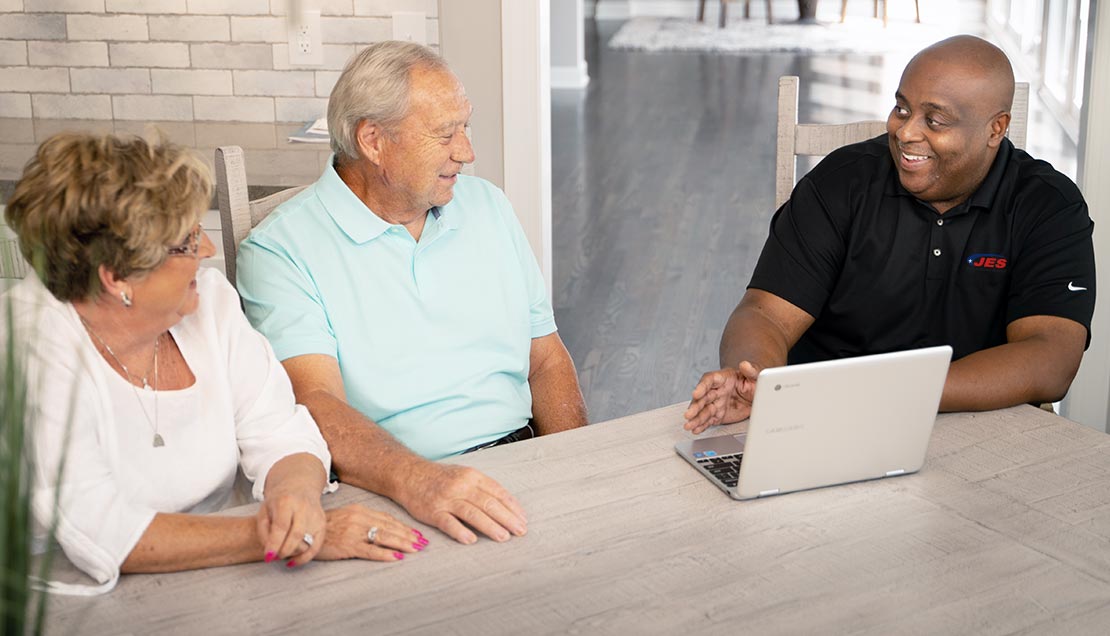
FAQs
More likely than not, your chimney actually has its own foundation that’s wholly separate from the rest of the home. Although this can be useful in giving the chimney enough support so it typically wouldn’t start sinking quickly, it can also be frustrating because that means it’s completely separate from your home, without the additional support necessary to keep it in one place.
Another possible cause is that the chimney’s foundation simply isn’t strong enough to support its weight, and it’s sinking into the ground. That can cause it to lean away from the rest of the home because one side will typically start to sink more quickly than the other side. This can cause the brick cracking that you’re noticing.
No matter which signs you’re noticing, it’s important to recognize that this is a real and serious problem. You don’t want your chimney to fall over entirely, after all. If you’re seeing that your chimney is starting to have a leaning problem, or you’re noticing a lot of cracked bricks around the ends of the chimney, it’s extremely important that you address it as soon as you can.
If your home ends up exposed to too much hydrostatic pressure over an extended period, your basement and main-level floors may begin to reflect some of your home’s overall strain. You can invest in repairs, however, instead of letting the damage therein grow worse. If you let that damage sit for too long, your floors may begin to take on water, becoming bouncy and squeaky as a result. If you want to repair your home’s squeaky and bouncy floors, you’re going to have to work to identify the source of unwanted moisture first.
You can work with professional contractors in your area to inspect your home and determine whether you have a leak on your hands. Should you have one, you’ll want to work to fix that leak before moving to repair your flooring. If you repair your floors before fixing the leak in your home, then your newly installed solutions may rapidly fall victim to the same damaging conditions that caused your floor to sag in the first place.
Tending to Your Squeaky Floors
If your floor is squeaking, it’s in your best interest to work with area contractors to install an IntelliJack™ support system. The IntelliJack™ support system uses galvanized steel to shore up floor joists and walls that have started to slump or bow due to the presence of high levels of moisture in your home.
The IntelliJack™ support system’s simple design makes it easy to install in a day or less. The professionals in your area can help you identify which joists in your home would best benefit from this additional aid. It doesn’t matter if the damage appears in your basement or crawl space. Each support jack has an allowable load capacity of more than 24,000 pounds, making this system an ideal addition to any home with floors that need a boost.
Fixing your damaged basement walls doesn’t have to be a complicated process. Instead, you can work with area professionals to determine what kind of solutions may help you restore your home’s original value. Bowing walls in your home benefit from additional support, as moisture and other forces can negatively impact your concrete walls. You have a few different options, in terms of supports.
IntelliBrace™ Beams, Wall Anchors, and Carbon Fiber Wall Reinforcements
For moderate to severely cracking and bowing walls, wall anchors are the best way to permanently stabilize these walls and help restore them to their original position over time. Comprised of heavy-duty earth anchors, galvanized steel rods, and interior wall plates, this system is idea to use when exterior installation space at least 10 feet away from the affected foundation walls is available.
The IntelliBrace™ system works much the same way in permanent reinforcement and gradual wall straightening. If you lack the exterior installation space for wall anchors, these special beams are your best bet. They are bolted to the floor and a floor joist, and a large-diameter bolt at the top of the floor joist can be adjusted in increments to help improve the wall’s condition.
For walls that are not severely cracking and bowing, carbon fiber wall reinforcements will prevent any further inward movement or influence of moisture. These low-profile straps firmly adhere to the walls to permanently hold them in their current positions.
Choosing the Best Solution for Your Home
When you find yourself faced with an extensive catalog of potential home repairs, it can be difficult to determine which may suit your needs best. If you’re feeling overwhelmed or confused, don’t worry. You’re not alone. You can discuss your budget and your home’s needs with the professionals in your area. If you invite professionals out to your home for a home inspection, you’ll have the chance to look over a free services quote detailing the exact means that can restore your home’s overall value.
Concrete block foundations consist of several blocks held together by caulk, mortar, or a similar substance. These types of foundations are on the older side, but they can help keep your home in one spot for years at a time. That said, block foundations are just as prone, if not more so, to the kind of damage that might put the structural integrity of your home at risk. Because these foundations are made of several individual pieces, you may readily find yourself contending with a stair-step crack should you identify any damage. Stair-step cracks, as the name suggests, tend to form along the mortar lines binding your foundation together. These cracks are indicative of excessive hydrostatic pressure and its impact on your home.
Exploring Your Options
You do, however, have the option to fix a stair-step crack should one develop in your block foundation. You should not attempt to go about the process of fixing such a crack on your own. Fixing a cracked foundation often requires you to excavate some of said foundation, a process that can take a considerable amount of time if you do not have the proper tools on hand.
Instead of trying to repair your foundation on your own, you can reach out to the professional contractors in your area. With their guidance and experience, you can determine what method of repairing your foundation—piers, for example, might best suit your needs.
Once your foundation is back up to snuff, note that you can also discuss potential waterproofing measures with the professionals in your area. This way, there will be less of a chance of stair-step cracks forming along the same lines or along alternative lines in the months or years to come.
You may find yourself contending with several types of cracks as a homeowner. Some of the most common include horizontal, diagonal, and stair-step cracks.
But vertical cracks also can find a home in your walls. These types of cracks tend to form along your walls, door frames, windows, and other locations. These cracks appear as a sign of potential damage to the structural supports protecting your home. Some of the most common causes behind the development of small vertical cracks in your walls include:
- Hydrostatic pressure. As water starts to build up outside of your home, it can cause the particles within your wall to change size. To compensate for the affiliated stress, your walls may begin to develop small vertical cracks.
- Wall shifting. If there is an excessive amount of moisture in your home, your walls may begin to bow inward as their structural supports become inundated with water.
- Tree roots. Tree roots do not actively move to attack the structural supports beneath your home. Instead, if a tree happens to be planted too close to the perimeter of your home, its roots can cause the soil around your aforementioned structural supports to shift. In doing so, it can disrupt the stability of your foundation and cause vertical cracks to appear in your walls.
No matter what steps you take, it is likely that your foundation is going to start to settle sometime in the years to come. Gravity is a force, unfortunately, that no one and nothing can ignore. As such, the force of gravity working against your home can cause your foundation to start to shift.
The term “settling” describes the process through which your home will start to sink into the ground. This sinkage will not occur all at once, nor will it be particularly noticeable at first. Instead, over the course of several years, your foundation may shift. Some common causes of unnatural foundation settling, or settling that takes place too quickly, include:
- The presence of nearby tree roots. While tree roots will never work maliciously against your home, they can leave gaps in the soil behind as they grow. They can also forcibly shift some of your below-ground structural supports, causing your foundation to shift and settle accordingly.
- Extended droughts. Droughts cause the soil particles in your yard to shrink in size. As those particles shrink, they’ll leave behind gaps. Your foundation, in turn, can begin to slowly sink into those gaps. While, again, the change will be neither immediate nor rapid, these particle gaps will cause your home to begin to settle far sooner than it would if the weather were more consistent.
- Pests and small animals. Groundhogs are prolific diggers, but can they really lower the overall value of your home? If these critters are left unattended, the answer is yes. Groundhogs, rabbits, and similar small animals can establish extensive burrows beneath the foundation of your home. If these burrows aren’t filled, then your foundation can begin to sink into them at a more rapid pace than it would solid soil.
Foundation failure is most often the result of extensive hydrostatic pressure. Hydrostatic pressure is the pressure that builds up outside of your home as water begins to press up against your structural supports. As that water moves in, it can force those materials making up your structural supports to rapidly change temperature.
As those materials change temperature, their particles will grow and shrink in size. To keep up with those rapid changes, your structural supports, from a concrete slab to the wooden beams you might have in your crawl space, can crack. While not all cracks are leaks, most leaks are cracks, and you’ll want to work quickly to try and prevent the more extensive damage that can be the result of water’s entry into your home. What causes water to build up outside of your home? The most common causes include:
- Poor drainage around the perimeter of your home. If you don’t make a point of regularly cleaning your gutters or checking on your downspouts, rain runoff can start to damage your foundation.
- Consistent bad weather. Droughts and heavy rains alike can cause problems for your foundation. Heavy rain, naturally, can expose your foundation to an excessive amount of water. Comparatively, droughts can cause the soil particles in your yard to shrink. As a result, your foundation can start to shift in a dangerous direction.
- Tree roots. If you have trees planted too close to your home, their roots may start to interfere with the structural integrity of your foundation.
- Interior leaks. Rapid changes in temperature can cause the pipes inside of your home to burst. Similarly, a poorly connected HVAC unit, washing machine, or other appliance can add moisture to your air. These leaks can have just as detrimental an impact on the health of your home as leaks that start outdoors.
The term “foundation failure” describes a broad category of structural failures you might find yourself contending with after a long year of excessive moisture. Your foundation, after all, is especially sensitive to the presence of moisture in your home, and it can show its discontent in a variety of ways. At first glance, many of these failures may seem superficial in nature. However, if you don’t attend to these problems quickly, they can evolve into conditions that require extensive repairs.
Some of the most common foundation failures include:
- Sticking windows and doors. As moisture makes its way into your home, you can find your doors and windows sticking as you try to open or close them. That difficulty stems from the presence of moisture in the wood or materials making up your door and window frames. Long-term exposure to excess moisture can cause these frames to warp, making it nearly impossible to return your windows or doors to their proper positions.
- Wall Cracks. The walls in your foundation can fall victim to water damage just as easily as walls elsewhere in your home. Hydrostatic pressure can cause your drywall or concrete to change size on a molecular level. The stress that these changes generate can cause your walls to develop horizontal, diagonal, and vertical cracks. Even brick walls can crack along their mortar, allowing moisture into your foundation and increasing the amount of hydrostatic pressure that your home has to contend with.
- Framing damage. The framework of your home needs to remain strong if you want to prevent your foundation from slipping or sinking. If you notice cracks in your framework or walls, there may be moisture in your walls for you to worry about.
- Buckling floors and other structural damage. Foundation failures can also include abruptly uneven floors or severe structural damage to your home’s accessories, from your front porch to your chimney. You’ll want to keep a wary eye out for these types of damage, as they can appear subtle at first. You can work with a professional contractor in your area to conduct an annual home inspection, allowing you to keep an eye on these accessories and to act on any damage you might find.
When it comes to repairing your home, you’ll want to be sure that you’ve invested in the right means of supporting your home. Choosing from a broad catalog of repair options can overwhelm even the savviest of homeowners, though. That’s where area professionals and their expertise come in handy. After a thorough home inspection, you can sit down with area contractors to explore those means of repair that might suit you best. These can include:
Piering and Concrete Lifting
If it appears that the problems you’re dealing with can be traced back to a sinking floor, then you may want to invest in floor supports or piers. Piers are designed to bear the weight of your home in your foundation’s stead. They also can potentially put your foundation back into position after it’s started to sink. Some of the most common types of piers include push piers, helical piers, and slab piers.
You also have the option to stabilize the soil around your foundation. Loose soil and the Clay Bowl Effect both make it more difficult for your home to remain in a stable position. Professionals in your area can use interior and exterior concrete lifting, often in the form of polyurethane injections, to both stabilize your soil and force your foundation back into its original position.
Wall Braces and Reinforcements
If the problems you’re contending with can be traced to your walls, piers and concrete lifting may not repair the damage you’re dealing with. Instead, you may want to invest in wall braces or carbon fiber reinforcements. Wall braces use a system of beams to help bowing walls return to their original positions. While these systems won’t fill leaks, they will stabilize your home so that its upper levels will see less moisture.
Carbon fiber wall reinforcements work in much the same way. Ten times stronger than steel, professionals can lay these reinforcement straps against your walls. Unobtrusive and easy for professionals to install, carbon fiber wall reinforcements permanently hold your walls in their current positions and keep them there even under threat of additional moisture damage. These types of reinforcements come with longtime warranties, as well.
Bowing floors in the kitchen typically showcase a foundation problem. For the most part, bowing floors occur when either your home is settling abnormally or you’re having a waterproofing problem. Either way, it’s definitely not a good sign and it’s absolutely something you should address as soon as possible.
Abnormal settling is something that happens in some homes. Some portions of the middle of the floor might be settling more quickly than the rest of the floor. That might occur because you have a very heavy piece in the center of your kitchen, which may be the case if you have an extremely heavy kitchen island, or it might simply be that the center of your kitchen doesn’t have enough support.
Waterproofing is another potential problem that you should be paying attention to. As with bouncy and squeaky floors, bowing floors, whether in the kitchen or otherwise, can be a sign of a moisture problem with the floor joists underneath. This is a problem that requires intervention as quickly as possible.
The thing is, there’s almost no way for you to know exactly what problem you’re having with the simple symptom of “bowing floors.” You could have either of these problems or you could have a more rare type of problem. That’s why the best way to fix your kitchen’s bowing floors is to schedule an inspection through JES.

